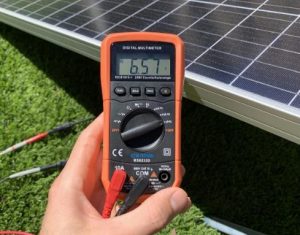How to Measure Solar Panel Output Using a Multimeter?
Measuring the output of a solar panel is crucial for ensuring optimal performance and troubleshooting issues. A multimeter, a versatile instrument used for various electrical measurements, can help you assess your solar panel's health by checking its voltage and current output. Here’s a step-by-step guide on how to measure solar panel output with a multimeter, empowering you to keep your solar system running at peak efficiency.

Understanding Solar Panel Specifications
Before you start, familiarize yourself with your solar panel's specifications. Typically, a solar panel will have a rated power output (measured in watts), open-circuit voltage (Voc), and short-circuit current (Isc). These values are key benchmarks for your measurements.
Setting Up Your Multimeter
First, ensure your multimeter is capable of measuring voltage (in volts) and current (in amperes). For measuring voltage, set your multimeter to the “DC Voltage” mode. To measure current, switch it to the “DC Current” or “Amps” mode. Make sure your multimeter’s range is suitable for the expected output of the solar panel.
Measuring Voltage Output
- Connect the Multimeter: Connect the multimeter’s probes to the solar panel's positive and negative terminals. Red goes to positive (+), and black goes to negative (-).
- Read the Voltage: With the solar panel exposed to sunlight, check the voltage reading on the multimeter. It should be close to the panel's Voc rating under ideal conditions.
Measuring Current Output
- Switch to Amps Mode: After measuring voltage, switch your multimeter to measure current. This might require moving the red probe to a different port on the multimeter.
- Connect in Series: Unlike voltage measurement, to measure current, you need to connect the multimeter in series with the solar panel and a load (like a solar charger controller or a battery). This means you'll disconnect one of the solar panel's leads and connect the multimeter between the lead and the load.
- Read the Current: With the solar panel still in sunlight, note the current reading. It should approach the panel's Isc rating under full sun.
Calculating Power Output
To calculate the power output of your solar panel, use the formula: Power (Watts) = Voltage (Volts) x Current (Amps). This calculation gives you the actual power output at the time of measurement, which you can compare to the panel's rated power output.
Safety Precautions
- Wear protective gear: Always wear safety glasses and gloves when handling electrical equipment.
- Beware of high voltages: Especially when measuring voltage, be aware that solar panels can produce high voltages that are dangerous.
- Avoid short circuits: Be particularly cautious to prevent short circuits when switching your multimeter to current mode.
Understanding how to measure solar panel output with multimeter is an invaluable skill for anyone looking to maintain, troubleshoot, or simply understand the performance of their solar panels. Regular measurements can help you spot issues early, ensuring your solar system continues to provide clean, renewable energy efficiently.
Measuring the output of a solar panel is crucial for ensuring optimal performance and troubleshooting issues. A multimeter, a versatile instrument used for various electrical measurements, can help you assess your solar panel's health by checking its voltage and current output. Here’s a step-by-step guide on how to measure solar panel output with a multimeter, empowering you to keep your solar system running at peak efficiency.
Understanding Solar Panel Specifications
Before you start, familiarize yourself with your solar panel's specifications. Typically, a solar panel will have a rated power output (measured in watts), open-circuit voltage (Voc), and short-circuit current (Isc). These values are key benchmarks for your measurements.
Setting Up Your Multimeter
First, ensure your multimeter is capable of measuring voltage (in volts) and current (in amperes). For measuring voltage, set your multimeter to the “DC Voltage” mode. To measure current, switch it to the “DC Current” or “Amps” mode. Make sure your multimeter’s range is suitable for the expected output of the solar panel.
Measuring Voltage Output
- Connect the Multimeter: Connect the multimeter’s probes to the solar panel's positive and negative terminals. Red goes to positive (+), and black goes to negative (-).
- Read the Voltage: With the solar panel exposed to sunlight, check the voltage reading on the multimeter. It should be close to the panel's Voc rating under ideal conditions.
Measuring Current Output
- Switch to Amps Mode: After measuring voltage, switch your multimeter to measure current. This might require moving the red probe to a different port on the multimeter.
- Connect in Series: Unlike voltage measurement, to measure current, you need to connect the multimeter in series with the solar panel and a load (like a solar charger controller or a battery). This means you'll disconnect one of the solar panel's leads and connect the multimeter between the lead and the load.
- Read the Current: With the solar panel still in sunlight, note the current reading. It should approach the panel's Isc rating under full sun.
Calculating Power Output
To calculate the power output of your solar panel, use the formula: Power (Watts) = Voltage (Volts) x Current (Amps). This calculation gives you the actual power output at the time of measurement, which you can compare to the panel's rated power output.
Safety Precautions
- Wear protective gear: Always wear safety glasses and gloves when handling electrical equipment.
- Beware of high voltages: Especially when measuring voltage, be aware that solar panels can produce high voltages that are dangerous.
- Avoid short circuits: Be particularly cautious to prevent short circuits when switching your multimeter to current mode.
Understanding how to measure solar panel output with multimeter is an invaluable skill for anyone looking to maintain, troubleshoot, or simply understand the performance of their solar panels. Regular measurements can help you spot issues early, ensuring your solar system continues to provide clean, renewable energy efficiently.